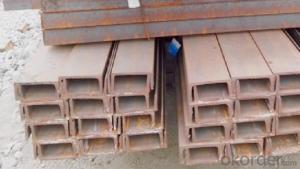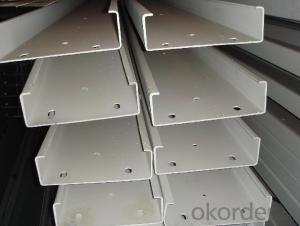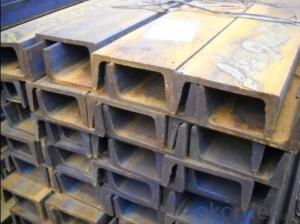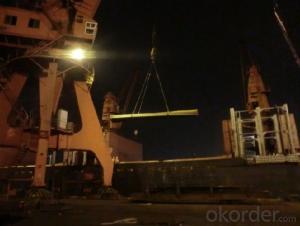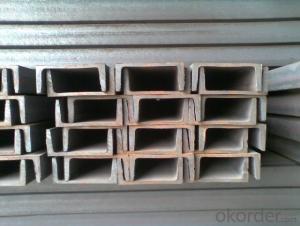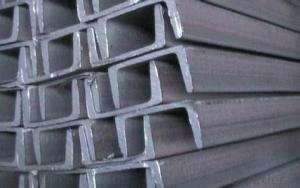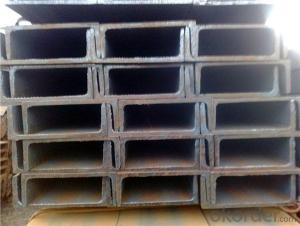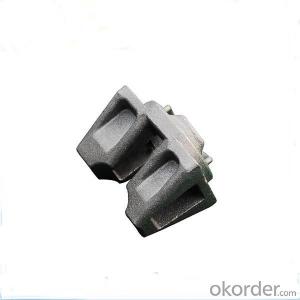Galvanized U Channel Steel Module of Q195-Q345,A36,SS400
- Loading Port:
- Tianjin
- Payment Terms:
- TT OR LC
- Min Order Qty:
- 2000 PCS
- Supply Capability:
- 38000 PCS/month
OKorder Service Pledge
Quality Product, Order Online Tracking, Timely Delivery
OKorder Financial Service
Credit Rating, Credit Services, Credit Purchasing
You Might Also Like
Galvanized Channel Steel Module of Q195-Q345,A36,SS400 Details
| Standard: | AISI,ASTM,BS,DIN,GB,JIS,JIS/ASTM/GB/BS | Dimensions: | 50*37*4.5-400*104*14.5 | Grade: | Q195-Q345 |
| Place of Origin: | China (Mainland) | Brand Name: | Centrue | Model Number: | #5-#40c |
| Shape: | U Channel | Application: | Building Structure etc.,Building Structure | Perforated Or Not: | Not Perforated |
| Length: | 3-12m | Thickness: | 4.5-14.5mm | Certification: | ISO9001 |
| Surface Treatment: | Galvanized/Oiled/Painted | Zinc: | 60um-80um |
Packaging & Delivery
| Packaging Detail: | To be packed in bundles wrapped with steel strip(or as customers requirements) |
| Delivery Detail: | 7-14 days |
Galvanized Channel Steel Module of Q195-Q345,A36,SS400 Specifications
1.Material grade:Q195-235,Q235B,Q345
2.Standard:GB/ASTM/JIS/BS
3.Specification:#5-#40c
4.Delivery time:7-14days (according to the volume of your order)
5.Package :To be packed in bundles wrapped with steel strip(or as customers requirements)
6.Certification:ISO9001
Galvanized Channel Steel Module of Q195-Q345,A36,SS400 Pictures


- Q: Can steel channels be used in marine environments?
- Yes, steel channels can be used in marine environments. However, it is important to note that the steel channels used must be corrosion-resistant or have appropriate protective coatings to withstand the harsh conditions of saltwater and prevent rusting. Regular maintenance and inspections are also necessary to ensure the longevity and performance of steel channels in marine environments.
- Q: How do steel channels compare to I-beams?
- Steel channels and I-beams are both structural components commonly used in construction and engineering projects. However, they differ in their shapes and load-bearing capacities. Steel channels have a U-shaped cross-section, while I-beams have an I-shaped cross-section. I-beams are generally stronger and more rigid than steel channels, making them suitable for supporting heavy loads over long spans. On the other hand, steel channels are often used for lighter applications, such as framing, bracing, and support in smaller structures. Ultimately, the choice between steel channels and I-beams depends on the specific requirements and load-bearing needs of the project.
- Q: Are steel channels suitable for earthquake-prone regions?
- Steel channels are indeed suitable for earthquake-prone regions. Steel is known for its high strength and ductility, making it a popular choice for earthquake-resistant construction. Steel channels, in particular, offer several advantages in seismic regions. Firstly, steel channels possess excellent load-bearing capabilities, allowing them to withstand the forces generated during an earthquake. Their shape provides structural rigidity and stability, minimizing the risk of collapse or damage. Steel's inherent flexibility also enables it to absorb and dissipate seismic energy, reducing the impact on the overall structure. Additionally, steel channels can be easily customized and fabricated to meet specific building requirements. This adaptability allows engineers to design structures with appropriate seismic resistance, ensuring that they can withstand the expected ground motion. Steel channels' dimensional accuracy and uniformity also contribute to better construction quality and performance during earthquakes. Another advantage of steel channels is their fire resistance. Unlike other building materials, such as wood or concrete, steel does not burn or contribute to the spread of fire. This characteristic makes steel channels a safer choice for earthquake-prone regions, where fires can often occur due to ruptured gas lines or electrical failures during seismic events. Moreover, steel's durability and resistance to corrosion make it ideal for long-term use in earthquake-prone areas. Steel channels require minimal maintenance and have a longer lifespan compared to other materials, ensuring the continued safety and stability of structures over time. In conclusion, steel channels are highly suitable for earthquake-prone regions due to their strength, ductility, load-bearing capabilities, adaptability, fire resistance, and durability. These qualities make steel channels a reliable choice for constructing earthquake-resistant buildings that can withstand the forces generated by seismic events.
- Q: How are steel channels used in construction?
- Steel channels have a wide range of applications in construction. One of their main uses is providing support and stability to a building's framework in structural applications. They are commonly used as beams or columns to bear heavy loads and resist bending or twisting forces. Additionally, steel channels are frequently utilized for framing and framing accessories, like door and window frames. They offer a rigid and long-lasting framework for the installation of doors, windows, and other fixtures. Furthermore, steel channels are used in the construction of ceilings, walls, and partitions. They can serve as support elements for attaching drywall or other finishing materials, ensuring strength and stability for the overall structure. Moreover, steel channels are employed in the construction of infrastructure projects such as bridges and highways. They act as structural components that can withstand heavy loads and provide the necessary strength and durability required for these types of constructions. In conclusion, steel channels are essential in construction due to their strength, versatility, and durability. They play a vital role in maintaining the stability and structural integrity of buildings, making them an indispensable component in the construction industry.
- Q: How do steel channels hold up against extreme temperatures?
- Steel channels are renowned for their exceptional strength and durability, rendering them highly capable of enduring extreme temperatures. The unique properties of steel, including its high melting point and thermal conductivity, enable steel channels to retain their structural integrity even in the face of extreme heat or cold. When subjected to high temperatures, steel channels exhibit a slower rate of expansion compared to other materials, thereby minimizing the risk of deformation or failure. This resistance to thermal expansion stems from the low coefficient of linear expansion inherent in steel. This property ensures that steel channels retain their shape and structural stability even amidst drastic temperature fluctuations. Moreover, steel channels boast excellent fire resistance. Steel possesses a high melting point, typically ranging from 1370°C to 1530°C (2500°F to 2800°F), thereby allowing it to withstand intense heat without compromising its structural integrity. Consequently, steel channels emerge as a dependable choice in applications where fire protection holds utmost importance, such as in buildings, bridges, or industrial structures. Conversely, steel also exhibits commendable performance in cold temperatures. Unlike certain materials that become brittle or weak when exposed to low temperatures, steel maintains its strength and ductility. Consequently, steel channels prove suitable for utilization in environments characterized by extremely cold temperatures, such as in arctic regions or cryogenic facilities. In conclusion, steel channels exhibit remarkable resilience to extreme temperatures owing to their low coefficient of linear expansion, high melting point, and overall durability. Regardless of exposure to intense heat or cold, steel channels retain their structural integrity and deliver long-lasting performance, thereby positioning themselves as a dependable choice in diverse applications.
- Q: How do steel channels contribute to the overall durability of a building?
- There are several ways in which steel channels enhance the durability of buildings. Firstly, their high strength and rigidity make them a reliable choice. Made from structural steel, which has exceptional load-bearing capabilities, steel channels offer strong support and prevent structural failure, ensuring the longevity of the building. Secondly, steel channels exhibit remarkable resistance to corrosion and rust. Unlike materials like wood or concrete, steel does not deteriorate over time when exposed to moisture or harsh weather conditions. This resistance to corrosion maintains the building's structural integrity, even in challenging environments or coastal areas. Moreover, the use of steel channels allows for greater design flexibility and versatility in construction. Architects and engineers can easily cut, shape, and weld steel channels, enabling the creation of complex building structures with precision. This customizability enhances the overall durability of the building and ensures a tighter and more secure fit. Furthermore, steel channels possess excellent fire resistance properties. They are non-combustible and do not contribute to the spread of flames in the event of a fire. This is particularly crucial in high-rise buildings or structures where fire safety is of utmost concern. Including steel channels significantly reduces the risk of structural collapse during a fire, enhancing the overall safety and durability of the building. Finally, steel channels have a long lifespan and require minimal maintenance. Thanks to their inherent strength and resistance to deterioration, they can withstand the test of time without frequent repairs or replacements. This not only decreases long-term building maintenance costs but also guarantees the building's durability over many decades. In conclusion, steel channels play a vital role in enhancing the overall durability of buildings. They provide robust structural support, resistance to corrosion and rust, design flexibility, fire resistance, and long-term reliability. Including steel channels in construction projects strengthens the building, ensures its safety, and extends its lifespan, making them a critical component in ensuring the durability of modern structures.
- Q: Can steel channels be used for machinery platforms?
- Yes, steel channels can be used for machinery platforms. Steel channels are often used in construction and industrial applications due to their strength and durability. They provide structural support and stability, making them suitable for supporting heavy machinery and equipment on platforms. Additionally, steel channels can be easily fabricated and customized to meet specific requirements, such as the size and load-bearing capacity needed for machinery platforms.
- Q: What is the cost of steel channels?
- The price of steel channels may differ due to a range of factors, including the steel's type and grade, the channels' size and length, and the prevailing market conditions. Steel channels find widespread use in construction, engineering, and manufacturing sectors for structural purposes. To obtain precise and current pricing details, it is advised to reach out to local suppliers or consult online platforms.
- Q: How do steel channels contribute to building security?
- Steel channels contribute to building security by providing structural support and reinforcement. They are commonly used in the construction of walls, floors, and roofs to enhance the overall strength and stability of the building. Steel channels help distribute the weight and loads evenly, making the structure more resistant to external forces such as strong winds, earthquakes, or impact. Additionally, they can be integrated with security systems to serve as barriers, preventing unauthorized access and enhancing the physical security of the building.
- Q: How do steel channels perform in terms of thermal insulation?
- Steel channels do not provide a significant amount of thermal insulation. As steel is a good conductor of heat, it allows heat to easily transfer through the material. This means that steel channels can act as a thermal bridge, allowing heat to escape or enter a building. To improve thermal insulation in a steel structure, additional insulation materials such as foam or mineral wool can be added to reduce heat transfer and enhance energy efficiency.
Send your message to us
Galvanized U Channel Steel Module of Q195-Q345,A36,SS400
- Loading Port:
- Tianjin
- Payment Terms:
- TT OR LC
- Min Order Qty:
- 2000 PCS
- Supply Capability:
- 38000 PCS/month
OKorder Service Pledge
Quality Product, Order Online Tracking, Timely Delivery
OKorder Financial Service
Credit Rating, Credit Services, Credit Purchasing
Similar products
Hot products
Hot Searches
Related keywords
